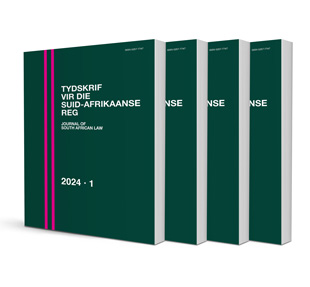A theory of (subjective) rights to minerals in South Africa

A theory of (subjective) rights to minerals in South Africa
Author: PJ Badenhorst
ISSN: 1996-2207
Affiliations: Associate Professor of Law, Deakin University; Honorary Professor of Law, Mandela University
Source: Tydskrif vir die Suid-Afrikaanse Reg, Issue 3, 2024, p. 453-468
https://doi.org/10.47348/TSAR/2024/i3a3
Abstract
Ingevolge die staat se bewaringsmag (imperium ofte wel administratiewe magte) kragtens die Mineral and Petroleum Resources Development Act 28 van 2002 is die staat bevoeg om nuwe kategorieë regte ten aansien van minerale aan aansoekers te verleen, naamlik prospekteerregte, mynregte, permitte en toestemmings. Die wetgewer onderskei tussen prospekteerregte en mynregte, aan die een kant, en toestemmings en permitte, aan die ander kant: prospekteerregte en mynregte word toegeken (“granted”) terwyl toestemmings en permittte deur die staat uitgereik (“issued”) word. Prospekteerregte en mynregte moet geregistreer word terwyl toestemmings en permitte aangeteken kan word. Die Wet op die Registrasie van Myntitels 16 van 1967 maak voorsiening vir die registrasie van prospekteerregte en mynregte en die aantekening van toestemmings en permitte ten aansien van minerale. Prospekteerregte en mynregte kan met ’n verband beswaar word terwyl dit nie moontlik is met permitte en toestemmings nie.
Die artikel ondersoek die inhoud van die staat se bewaringsmag teen die agtergrond van die toekenning of uitreiking van prospekteerregte, mynregte, permitte en toestemmings ten aansien van minerale. Die bevoegdhede van die staat uit hoofde van die bewaringsmag word bespreek. ’n Teorie van mineraalregte word ontwikkel deur die inhoudsbevoegdhede van prospekteerregte, mynregte, permitte en toestemmings te isoleer. Die teenwoordigheid van hierdie bevoegdhede in regte, permitte en toestemmings word aangetoon. In die ontwikkeling van so ’n teorie moet voorts duidelik onderskei word tussen administratiewe regte, persoonlike regte en beperkte saaklike regte. Die artikel verduidelik wat juridies plaasvind wanneer regte, permitte en toestemmings ten aansien van minerale aanvanklik (administratiefregtelik) toegeken of uitgereik word. Die statutêre verpligting wat uit sodanige administratiewe handeling voortspruit, word aangetoon.
Tydens die sluit van ’n prospekteerkontrak of mynkontrak word persoonlike regte geskep terwyl beperkte saaklike regte by registrasie tot stand kom. Die standpunt word gehuldig dat administratiewe regte nie omgetower word in saaklike regte met registrasie nie en dat die onderskeid tussen persoonlike regte en saaklike regte tydens kontraksluiting en registrasie nie misken behoort te word nie.
Die beperking van die bevoegdhede van die staat se administratiewe magte met die registrasie van prospekteerregte en mynregte word bespreek. Verdere beperkings van die staat se magte word ook uitgespel. Die artikel ondersoek ook die moontlike beperking van die bevoegdhede van die staat se magte tydens die aantekening van permitte of toestemmings.
Daar word geargumenteer dat sekere toestemmings en permitte ook as saaklike regte erken moet word. Hierdie beskouing word ondersteun deur te fokus op die objek van ’n reg uit hoofde van die leerstuk van subjektiewe regte. Die slotbeskouing is dat indien die staat se bevoegdhede kragtens die staat se bewaringsmag geïsoleer word, kan dit as vertrekpunt gebruik word om die regsaard en inhoud van regte, permitte en toestemmings dogmaties te verduidelik.